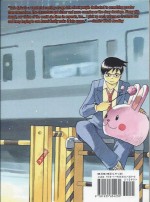

By Kou Yaginuma (Vertical)
ISBN: 978-1-935654-23-0
Kou Yaginuma first captured the hearts and minds with poignant short story 2015 Nen no Uchiage Hanabi (2015: Fireworks, published in Gekkan Comics Flapper, June 2000), before expanding the subject and themes into a major manga epic combining hard science and humanist fiction with lyrical mysticism and traditional tales of school-days and growing up.
2024 AD: diminutive teenager Asumi Kamogawa has always dreamed of going into space. From her earliest moments the solitary child gazed up at the stars with imaginary friend Mr. Lion, especially gripped by the twinkling glow of Virgo and alluring binary star Spica.
An isolated, serious child, she lived with her father, a common labourer who had once worked for the consortium which built the rockets for Japan’s Space Program.
When Asumi was one year old, the first Japanese manned launch ended in catastrophe after rocket-ship ShishigÅ (“The Lionâ€) exploded during its maiden flight: crashing to earth on the coastal city of Yuigahama. Hundreds were killed and many more injured, including Asumi’s mother.
Maimed and comatose, the matron took years to die. The shock crushed her grieving husband and utterly traumatised infant Asumi.
In response to the disaster Japan set up an astronautics and space sciences training facility where, after years of determined struggle, Asumi was accepted by the Tokyo National Space School. Slowly making friends like Shinnosuke Fuchuya (who used to bully her as a child in school), boisterous Kei Oumi, chilly and distant Marika Ukita and spooky, ultra-cool Shu Suzuki, Asumi inexorably moved closer to her unshakable dream of going to the stars.
Against all odds – she is small, shy, retiring, looks weak and is very poor – Asumi endures and always succeeds. She still talks with Mr. Lion, who seems to be the ghost of an astronaut from the ShishigÅ…
Individual instalments in these compelling monochrome volumes are presented as “Missionsâ€, methodically combining into an overarching mosaic detailing the subtle interconnectedness of generations of characters, all linked by the call of the heavens.
Volume 9 comprises numbers 47-55, and also includes a brace of enchanting autobiographical vignettes from the author’s own teenage years.
As Asumi sleeps the story resumes with Mission: 47 and a flashback to happier times in Yuigahama when the class buried a time capsule and revealed what they wanted to do as adults. There and then brash little Fuchuya found a library book with a picture of an astronaut who had come from the tragic town…
The repose resolves into a rush as Asumi and Kei hurry to their first day as Juniors at the Tokyo School. En route they discover classmate Shu Suzuki has become an overnight celebrity as news of his short-listing to join a US space mission has become public. They are even door-stepped at the gate by an inquisitive reporter who has his own reasons for remembering the Lion…
The jaded hack’s breath is taken away when enigmatic, aloof Ukita follows them in. He has seen her before – or a least someone from long ago who looks exactly as she does now…
Tetchy Fuchuya’s impatience with the Principal’s welcome speech is only exacerbated when the girls of the new intake bombard him with stupid questions about classmate and superstar Shu. His mood is only changed later when he inadvertently discovers proud Ukita is secretly working in a coffee shop…
Nothing stops Kei flying off the handle when a bunch of loudmouths snipe behind Suzuki’s back, accusing him of using Space School to further his well-connected family’s political ambitions. Only Shu himself can convince the infuriated girl to back down and apologise. He doesn’t care what anybody says: he’s one step closer to space…
And at Asauri News HQ, journalist Ichimura finally finds a photo of that troubling girl from decades ago…
Mission: 48 sees Asumi welcoming new student Mikan Tokushima to the Seagull Hostel before reporting to class for the latest in the never-ending series of gruelling physical and mental challenges designed to winnow out all but the very best potential astronauts. The arduous decompression tests seem to have a salutary effect on Oumi though; she has never seemed so determined or uncomplaining. Perhaps it’s because she loves Suzuki and wants to be worthy of him…
When a little kid gives Asumi a note and map, the trail takes her to a certain coffee shop and a strange confrontation with Marika. It seems the ice-maiden has been taking steps to learn how to interact with people…
Asumi is unsettled. As she discusses things with Mr. Lion that night, it feels like she is the only one incapable of change or progress. She couldn’t be more wrong, as unwilling big-shot Shu points out to Mikan whilst they watch her doggedly run on the sports track next day. Everyone else in class envies her determination and covets her stamina: she’s the one the entire new intake should be patterning themselves on…
Mission: 49 offers another revelatory flashback as a relentless and troubled man finally uncovers the truth behind the Lion: how government cost-cutting, political chicanery and PR glad-handing resulted in a second-rate spaceship and a rush to launch before every detail was checked. Now in possession of the full facts, aggrieved Dr. Sano is ready to make the guilty ones pay and he’s starting with Space School Chair Mr. Shiomi…
As he’s taken away by police, Sano asks Asumi to give a package to her dad; his fellow disgraced rocket design engineer on the Lion project…
In the wake of the ShishigÅ disaster, Tomoro Kamogawa was assigned by the corporation who built the ship to head a reparations committee. Guilt-wracked and personally bereaved, the devastated technologist had to visit and formally apologise to each and every survivor or victim’s grieving family. The experience completely destroyed him.
He lost all joy and faith in the space program, having lost his wife, his career and his pride to the race for the stars. He raised his daughter alone by working two and often three menial jobs at a time for over a decade and could not countenance losing the very last of his loved ones to the cold black heavens.
Eventually he accepted Asumi’s decision and dream but as Mission: 50 opens, the records Sano has sent to his old lab partner carry him spiralling back to those heady days of his own stellar ambitions…
Sano has his own memories to torment him: a wonderful woman who loved him and went to Yuigahama to witness his “triumphâ€, even though he stubbornly refused to go.
A little later, the old engineering comrades meet up again and share a new dream…
Life goes on and training continues in Mission 51 with the Junior year experiencing their first taste of the G-Force simulator. When Shu has an adverse reaction, Ukita is particularly concerned. She has seen his symptoms before but Suzuki brushes it all off and asks her not to report what she suspects…
The quixotic class frontrunners are slowly becoming inseparable friends and as days pass Marika becomes embroiled by a strange new mystery: someone is leaving her odd cartoon messages at work…
And in a playground lonely Mr. Lion is lost in his own memories; concerned if he is really helping his “little oneâ€â€¦
Mission 52 finds Asumi coping with an unexpected and perhaps unwelcome visitor. Kasane Shibata is an old schoolmate from Yuigahama whom Asumi barely knew, but now she’s come looking for something but cannot explain what or why…
In 53 the mystery deepens as Kasane’s obvious lie about attending preparatory exam classes is proved false when Fuchuya catches her sleeping in a park, but Asumi’s gentle confrontation in Mission 54 not only uncovers the roots of her fellow crash survivor’s problems but also offers her a new path to happiness…
The story glides to a temporary halt with Mission 55 as at Asauri News, Ichimura gets closer to an astounding conclusion whilst at Space School the Juniors learn of their next extra-curricular exercise. There is a frightening subtext to the outing: they will be competing against robots that the funding authorities are considering using in space instead of – not beside – living astronauts…
Moreover, whilst the students fret and train, journalist Ichimura intently watches Marika, having just uncovered her improbable connection to life-sciences mogul Senri Ukita, a publicity-shy mystery-man the reporter knows from long ago…
To Be Continued…
Also included in this volume are two more wistfully autobiographical ‘Another Spica’ vignettes culled from author Yaginuma’s lovelorn days as a part-time server on a soft-drink stand in a theme park; the first focussing on his youthful ambitions – girls or drawing – whilst the latter ponders the power and worth of regret…
These magically moving marvels originally appeared in 2006 as Futatsu no Supika 10 and 11 in the Seinen manga magazine Gekkan Comics Flapper, targeted at male readers aged 18-30, but this ongoing, unfolding beguiling saga is perfect for any older kid with stars in their eyes…
Twin Spica ran from September 2001-August 2009: sixteen volumes tracing the trajectories of Asumi and friends from callow students to trained astronauts, and the series has spawned both anime and live action TV series.
This delightful saga has everything: plenty of hard science to back up the informed extrapolation, an engaging cast, mystery and frustrated passion, alienation, angst and true friendships; all welded seamlessly into a joyous coming-of-age drama with supernatural overtones, raucous humour and masses of sheer sentiment.
These books are printed in the Japanese right to left, back to front format.
© 2011 by Kou Yaginuma/MEDIA FACTORY Inc. Translation © 2011 Vertical, Inc. All rights reserved.
